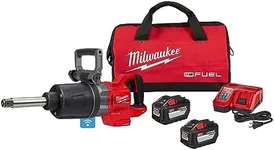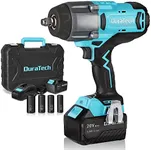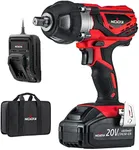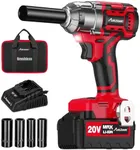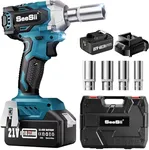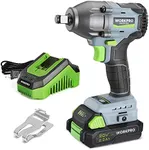Buying Guide for the Best Milwaukee Impact Guns
When choosing an impact gun, it's important to consider the specific tasks you'll be using it for. Impact guns, also known as impact wrenches, are powerful tools designed to deliver high torque output with minimal exertion by the user. They are commonly used in automotive repair, heavy equipment maintenance, product assembly, and construction projects. To find the best fit for your needs, you should evaluate several key specifications that will determine the tool's performance and suitability for your tasks.TorqueTorque is the rotational force that the impact gun can deliver. This spec is crucial because it determines the tool's ability to loosen or tighten bolts and nuts. Torque is measured in foot-pounds (ft-lbs) or Newton-meters (Nm). For light-duty tasks, such as small automotive repairs, a torque rating of 100-200 ft-lbs may be sufficient. For medium-duty tasks, like larger vehicle maintenance, look for 200-400 ft-lbs. Heavy-duty tasks, such as industrial applications, may require 400 ft-lbs or more. Choose a torque rating based on the toughest job you expect to handle.
Drive SizeThe drive size refers to the size of the square drive that holds the socket. Common sizes include 1/4-inch, 3/8-inch, 1/2-inch, 3/4-inch, and 1-inch. The drive size you need depends on the size of the fasteners you'll be working with. For small fasteners, a 1/4-inch or 3/8-inch drive is suitable. For general automotive work, a 1/2-inch drive is most common. For larger fasteners in heavy equipment or industrial settings, a 3/4-inch or 1-inch drive may be necessary. Match the drive size to the typical fasteners in your projects.
Speed (RPM)Speed, measured in revolutions per minute (RPM), indicates how fast the impact gun can rotate. Higher speeds allow for quicker fastening and loosening of bolts. Light-duty impact guns may have speeds around 2,000-3,000 RPM, while heavy-duty models can exceed 5,000 RPM. If you need to complete tasks quickly, opt for a higher RPM. However, for precision work, a lower speed with better control might be more appropriate. Consider the balance between speed and control based on your specific needs.
Impacts Per Minute (IPM)Impacts Per Minute (IPM) measures how many times the hammer mechanism strikes the anvil each minute. This spec affects the tool's ability to break loose stubborn fasteners. Higher IPM values generally mean more effective performance. Light-duty impact guns may have around 2,000-3,000 IPM, while heavy-duty models can reach 4,000 IPM or more. If you frequently deal with rusted or over-torqued bolts, a higher IPM will be beneficial. Choose an IPM rating that matches the difficulty of the fasteners you encounter.
WeightThe weight of the impact gun can affect user comfort and fatigue, especially during extended use. Lighter models, typically under 5 pounds, are easier to handle and maneuver, making them suitable for overhead or repetitive tasks. Heavier models, over 7 pounds, may offer more power but can be tiring to use for long periods. Consider the duration and nature of your tasks when selecting the weight. If you need to use the tool for extended periods or in awkward positions, a lighter model may be more comfortable.
Power SourceImpact guns can be powered by electricity (corded or cordless) or air (pneumatic). Corded electric models offer consistent power but require access to an outlet. Cordless models provide mobility and convenience, with battery life being a key consideration. Pneumatic models, powered by compressed air, are often more powerful and lighter but require an air compressor. Choose the power source based on your work environment and mobility needs. For stationary work, corded or pneumatic models are ideal. For on-the-go tasks, a cordless model offers the best flexibility.


